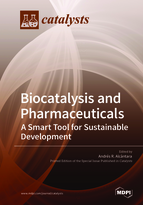Biocatalysis and Pharmaceuticals: A Smart Tool for Sustainable Development
A special issue of Catalysts (ISSN 2073-4344). This special issue belongs to the section "Biocatalysis".
Deadline for manuscript submissions: closed (28 February 2019) | Viewed by 63155
Special Issue Editor
Interests: enzymatic synthesis of drugs and bioactive compounds; sustainable processes; biocatalyst upgrading; pharmaceutical industry; organic chemistry; pharmaceutical chemistry
Special Issues, Collections and Topics in MDPI journals
Special Issue Information
Dear Colleagues,
In the last years, the advances in bioinformatics, enzyme evolution or process intensification have enlarged the effectiveness of biotransformations, accelerating the rate at which new enzymes are becoming available, even for promiscuous activities not previously known. Thus, now it is possible to join the exquisite enzymatic precision and inherent sustainability associated to the employ of biocatalysts with the possibility of generating new and more robust biocatalysts, expanding the biocatalytic toolbox, moving inside a time scale more compatible with the demands of pharmaceutical industry. For these reasons, it seems clear that we are entering in a new scenario, in which biocatalysis will play an even more significant role in such a competitive and demanding industry.
This Special Issue aims to gather contributions from research groups, rather original research or up-to-date revisions, to illustrate recent advances in this fascinating area. This includes, but is not restricted to, the discovery of new enzymatic activities, the chemical or genetic modification of known biocatalysts for further application in the development of new drugs, and the implementation of biocatalyzed protocols to increase the sustainability in the synthesis of drugs and bioactive molecules.
Prof. Andres R Alcantara
Guest Editor
Manuscript Submission Information
Manuscripts should be submitted online at www.mdpi.com by registering and logging in to this website. Once you are registered, click here to go to the submission form. Manuscripts can be submitted until the deadline. All submissions that pass pre-check are peer-reviewed. Accepted papers will be published continuously in the journal (as soon as accepted) and will be listed together on the special issue website. Research articles, review articles as well as short communications are invited. For planned papers, a title and short abstract (about 100 words) can be sent to the Editorial Office for announcement on this website.
Submitted manuscripts should not have been published previously, nor be under consideration for publication elsewhere (except conference proceedings papers). All manuscripts are thoroughly refereed through a single-blind peer-review process. A guide for authors and other relevant information for submission of manuscripts is available on the Instructions for Authors page. Catalysts is an international peer-reviewed open access monthly journal published by MDPI.
Please visit the Instructions for Authors page before submitting a manuscript. The Article Processing Charge (APC) for publication in this open access journal is 2700 CHF (Swiss Francs). Submitted papers should be well formatted and use good English. Authors may use MDPI's English editing service prior to publication or during author revisions.
Keywords
- Biocatalysis
- Biotransformations
- Drug synthesis
- Sustainable Chemistry
- Biocatalyst engineering






